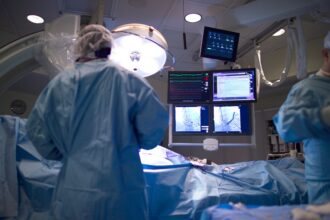With onerous operational requirements, healthcare facilities face unique challenges in trying to go green. We’ve compiled some top tips for becoming a more eco-friendly establishment: WATER As we all know, water is a precious resource – one which needs to be conserved as much as possible. For anyone involved in healthcare, high water usage seems unavoidable. This is necessary for patient comfort and hygiene and for maintaining the high level of cleanliness required to sanitize general and kitchen areas and individual wards. However, on examination, healthcare facilities tend to waste exorbitant amounts of water.
- Modern equipment such as dishwashers and shower heads feature water-wise technologies. If you are building a new healthcare facility, it is worth investigating this equipment for the long-term water and cost savings. For existing facilities, factor this into your future budget plans and refurbishments.
- Maintenance – Schedule regular maintenance of your equipment. If you aren’t replacing your equipment anytime soon, maintenance can yield some water savings. When machinery is operating optimally, it can use less water and energy. If you work with a facilities maintenance company, they will be able to tell you when old equipment needs replacing and give you invaluable insights into the functional requirements of your facility’s different components.
- Look at how you clean – Cleaning detergents go down the drain and often into our general water supply. Switching to eco-friendly detergents wherever possible prevents contamination and reduces the amount of chemicals in the environment.
- Look into water harvesting – Many water-intensive practices in healthcare facilities do not need fresh, clean water to operate. Harvesting rainwater and grey water for things like flushing the toilet can have a notable long-term effect on the amount of water used by the average healthcare facility.
WASTE
Healthcare facilities have a reputation for generating large amounts of waste – including hazardous waste.
- Work with a registered waste management company which is environmentally conscious when it comes to waste management and disposal. These experts will also be able to help you devise a waste management and recycling strategy to suit your unique circumstances.
- Work with a waste management company which has a thorough network. This reduces the carbon footprint associated with trucking waste to its final destination – and lowers the cost of transportation at the same time.
- Look into single-use waste items. Particularly in the field of surgical equipment, the medical industry is seeing an increase in the amount of re-usable components. Where possible, sterilize and re-use components rather than dispose of them.
- Pay it forward when it comes to your medical equipment. Re-sell or recycle equipment to other local and international facilities.
ELECTRICITY
- If you are building a new healthcare facility, make natural light a design consideration. Maximizing the amount of natural light in wards, offices, and general areas has a corresponding effect on the amount of lighting required in these spaces.
- Switch to energy-efficient lightbulbs – Switching to energy efficient lightbulbs can have a marked effect on the amount of energy used to light different areas of your healthcare facilities – another point where saving the environment can have a positive effect on your bills too.
- Invest in tech – Gone are the days of leaving the lights on throughout your facility – including broom closets, storage rooms, and unoccupied areas. Motion sensor lighting is a wonderful way to negate the waste and keep your passageways, bathrooms, and sporadically occupied spaces well-lit at the same time. Different equipment these days also has built-in energy efficient technology.
- Maintain the health of your equipment – Regular maintenance is the key to energy-efficient equipment. Get a team of experts to ensure your heating and cooling is working optimally (if it’s not, it will use more energy to perform), inspect your insulation, and make recommendations on energy saving strategy for your unique circumstances.
- Understand your usage – Identifying what is responsible for energy consumption – particularly during peak periods – is the first step in changing behavior. Using energy management software and consulting energy consultants can make a very big difference in usage and cost of energy.
YOUR ENVIRONMENTAL IMPACT
- Interrogate your whole value chain – Identify and strategize around how to reduce the amount of deliveries your facility receives and shorten the route wherever possible. One very easy way to reduce your carbon footprint is to use locally-sourced produce for stocking your kitchens and cafeterias. This can also lead to reduced refrigeration requirements. Supporting community enterprises – with health benefits of farm-sourced local produce – can also have a meaningful impact as a marketable point for your healthcare facility.
- Make paper a thing of the past – Contrary to popular belief, the administration of your healthcare facility does not rely on paper. Going paperless has a positive effect in minimizing the need for resource-intensive forestry, but also reduces the amount of energy used for printing and the costly and wasteful use of disposable ink cartridges. Give your patients the option of going paperless, print on demand, and encourage digital communication and record-keeping wherever possible. This also has the potential to increase the lifespan of your printing equipment, so reducing the amount of electrical waste sent to landfill.
- Make it a team effort – Eco-friendly strategy requires the buy-in of your whole team – whether you are a small team or a large hospital. Invite your staff members to generate ideas and inform them of your eco-friendly initiatives and their responsibilities.
Conclusion
Implementing eco-friendly measures at healthcare facilities combines environmental concerns, operational requirements, and patient well-being; thus, it can be a daunting process. With trends rapidly changing within the industry, these facilities face the pressure to transform, and they may need some expert assistance to do so.








